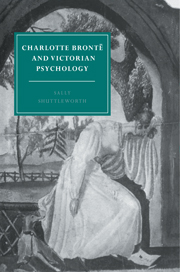Book contents
- Frontmatter
- Contents
- Acknowledgements
- Introduction
- PART ONE PSYCHOLOGICAL DISCOURSE IN THE VICTORIAN ERA
- 1 The art of surveillance
- 2 The Haworth context
- 3 Insanity and selfhood
- 4 Reading the mind: physiognomy and phrenology
- 5 The female bodily economy
- PART TWO CHARLOTTE BRONTË'S FICTION
- Conclusion
- Notes
- Index
- CAMBRIDGE STUDIES IN NINETEENTH-CENTURY LITERATURE AND CULTURE
1 - The art of surveillance
Published online by Cambridge University Press: 06 November 2009
- Frontmatter
- Contents
- Acknowledgements
- Introduction
- PART ONE PSYCHOLOGICAL DISCOURSE IN THE VICTORIAN ERA
- 1 The art of surveillance
- 2 The Haworth context
- 3 Insanity and selfhood
- 4 Reading the mind: physiognomy and phrenology
- 5 The female bodily economy
- PART TWO CHARLOTTE BRONTË'S FICTION
- Conclusion
- Notes
- Index
- CAMBRIDGE STUDIES IN NINETEENTH-CENTURY LITERATURE AND CULTURE
Summary
In a crucial scene in Villette, Dr John directs onto Lucy Snowe the interpretative gaze of medical science: ‘I look on you now from a professional point of view, and I read, perhaps, all you would conceal – in your eye, which is curiously vivid and restless; in your cheek, which the blood has forsaken; in your hand, which you cannot steady’. He speaks with unshakeable authority, calmly confident of his professional ability to reveal the hidden meaning of Lucy's inner state. As text, Lucy opens herself up to his readerly skills. Every outer sign becomes an active invitation to his interpretative penetration. The exchange presents a literal enactment of the metaphorical structure of western science: male science here unveils female nature, piercing through her outer layers to reveal her hidden secrets. Within this wider historical framework, however, the scene possesses a more immediate specificity, drawing attention to the new theories of subjectivity which arose in the nineteenth century. Selfhood no longer resided in the open texture of social act and exchange, but within a new interior space, hidden from view, inaccessible even to the subject's own consciousness. Nor was inner self necessarily legible from or immanent within outer sign. The book of the self was not laid open for all to read; specific knowledge and skills were required to decode its language.
This interiorized model of selfhood laid the foundations for later Freudian theory which still dominates our understanding of subjectivity.
- Type
- Chapter
- Information
- Charlotte Brontë and Victorian Psychology , pp. 9 - 18Publisher: Cambridge University PressPrint publication year: 1996

